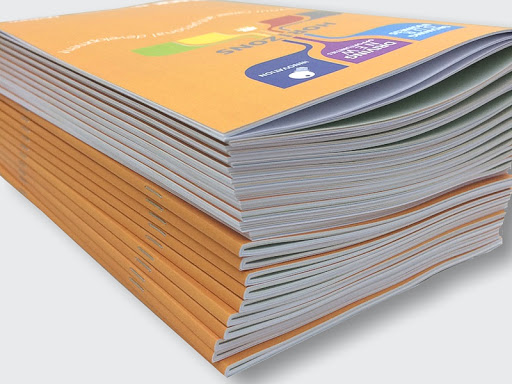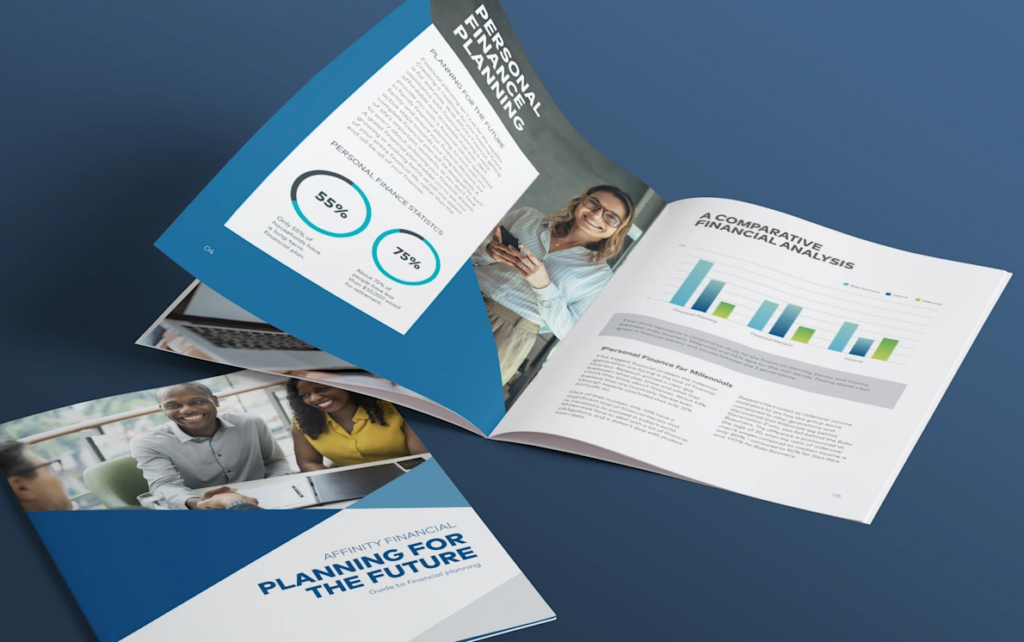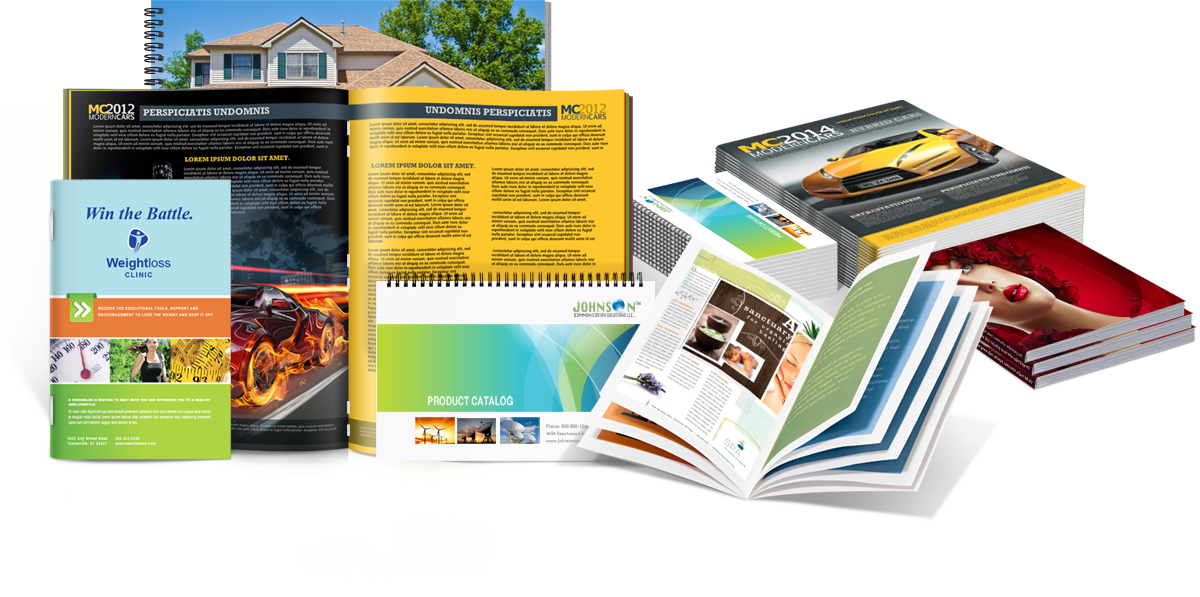How to Combine Print and Digital for Next-Level Booklet Printing
How to Combine Print and Digital for Next-Level Booklet Printing
Blog Article
The Essential Overview to Understanding Brochure Printing Options and Techniques
The process of pamphlet printing includes numerous considerations that can greatly impact the end product. From choosing the appropriate style and dimension to understanding the subtleties of binding approaches, each option plays a crucial role. In addition, elements such as paper supply and printing strategies additional influence the effectiveness of the pamphlet. As one browses these choices, it becomes imperative to comprehend just how they interconnect and what that indicates for the total end result.
Comprehending Booklet Sizes and layouts
When considering brochure printing, recognizing the numerous layouts and dimensions available is essential for achieving the preferred presentation. Pamphlets can be generated in various styles, consisting of saddle-stitched, spiral-bound, and perfect-bound, each offering distinct advantages. Typical sizes vary from common letter (8.5 x 11 inches) to smaller choices like A5 (5.8 x 8.3 inches), enabling for flexibility based on web content and target audience.Selecting the proper dimension can influence both the design and viewers interaction. Bigger dimensions may match aesthetically driven web content, while smaller sized formats may be extra portable and straightforward. Furthermore, the number of pages affects the choice of binding approach, as thicker brochures might call for sturdier bindings. Eventually, understanding these aspects enables a much more tailored method, ensuring that the end product aligns with the designated message and aesthetic, enhancing the total performance of the interaction.
Choosing the Right Paper Stock

Binding Techniques: Choices and Considerations
When it pertains to binding techniques for booklets, several choices are offered, each with distinctive benefits. Saddle stitch binding provides a cost-efficient solution for thinner pamphlets, while best binding techniques offer a more sleek search for thicker magazines. Wire-O binding sticks out for its durability and ease of usage, making it suitable for files that call for flexibility.
Saddle Stitch Binding
Saddle stitch binding offers a useful and cost-effective option for setting up brochures, making it a preferred choice amongst authors and businesses. This binding technique includes folding sheets of paper in half and stapling them along the fold line, creating a cool and organized appearance. Typically suitable for pamphlets with a lower page count, saddle stitching is ideal for magazines, brochures, and instructional products. The simplicity of this strategy enables for quick production and is usually preferred for marketing things or short runs. It is important to keep in mind that saddle stitch binding may not be ideal for thicker pamphlets, as the spine might not hold up under increased weight. On the whole, it stays a trusted option for many printing projects.
Perfect Binding Methods
Perfect binding is an extensively used strategy that gives a specialist and sleek coating to magazines and pamphlets. This method entails gluing the web pages with each other at the back using a strong adhesive, permitting a tidy edge and the capability to hold a larger variety of web pages contrasted to saddle stitching. Perfect binding is particularly appropriate for thicker brochures, such as catalogs and yearly reports, where a durable, flat back is preferred. Furthermore, it uses the alternative for a published cover that can be developed to boost visual charm. Nevertheless, factors to consider such as web page matter, paper weight, and the intended use the pamphlet must be thought about, as they can affect longevity and overall top quality.
Wire-O Binding Options
Wire-O binding, known for its sturdiness and versatility, provides a superb option for pamphlets that call for simple page transforming and an expert look. This binding method employs a collection of steel loopholes that hold web pages firmly, allowing them to lie level when open. It is specifically suitable for magazines, guidebooks, and presentations as a result of its robust nature. Wire-O binding is offered in various shades and sizes, fitting various page matters and thicknesses. In addition, it permits the addition of covers and tabs, improving the brochure's total visual. Factors to consider for Wire-O binding include the choice of cord color, the size of the loops, and the level of personalization preferred, all of which can greatly influence the final product's appearance and capability.
Digital vs. Offset Printing: Which Is Best for You?
When choosing a printing approach for pamphlets, comprehending the differences in between digital and balance out printing is essential. Digital printing makes use of modern-day innovation to create high-quality prints swiftly and cost effectively, making it ideal for short runs or jobs calling for quick turnaround times. It enables modification, offering the capacity to publish on-demand with marginal waste.In contrast, offset printing is a conventional method that excels in creating huge amounts with regular top quality. It involves moving ink from a plate to a rubber covering, then to the paper, which causes specific details and lively shades. Nevertheless, offset printing generally needs longer arrangement times and is extra economical for bigger volumes.Ultimately, the selection in between electronic and offset printing depends on project demands, budget, and wanted amount. For tiny, time-sensitive projects, digital might be the most effective option, while balanced out may be preferable for larger, top quality productions.

Designing Your Pamphlet: Tips and Finest Practices
When designing a pamphlet, careful interest to format, font style choice, and shade usage can significantly enhance its effectiveness. A well-structured layout overviews the viewers's eye, while proper font styles ensure readability and communicate the wanted tone. Additionally, reliable use of shade can stimulate feelings and highlight crucial details, making the general layout more impactful.
Picking the Right Format
Exactly how can one effectively select the best design for a pamphlet? It is crucial to review the booklet's purpose and target audience. A tidy, arranged layout boosts readability and interaction. Using a grid system can assist in straightening elements regularly, developing a specialist appearance. Additionally, incorporating visual hierarchy via differing sizes and positionings of images and text can lead the reader's eye and stress vital information. It is likewise crucial to leave enough white area, which stops overcrowding and enables much better focus. Testing different formats via mock-ups can supply understanding right into just how the style executes in real-world situations, making certain that the final product meets both aesthetic and practical demands.
Selecting Proper Font Styles
A well-chosen font can significantly enhance the general layout of a booklet, matching the layout and reinforcing the material's message. The choice of fonts ought to consider readability, particularly for body text, as it ensures the details comes to all readers. Sans-serif typefaces are often favored for electronic layouts, while serif fonts can provide a traditional feel in printed materials. It's a good idea to restrict font choices to 2 or three to maintain visual coherence. In addition, font dimension plays a crucial function; headings must be not frustrating however distinct, while body text should fit for reading. When picking font styles, placement with the pamphlet's style and target market is essential for efficient communication and aesthetic charm.
Effective Use Color
Color functions as a powerful device in brochure layout, shaping perceptions and guiding visitor emotions. It can stimulate feelings of peace, trust fund, or enjoyment, depending on the hues chosen. Developers need to take into consideration shade theory concepts, making sure that the chosen scheme straightens with the booklet's message and target market. For example, utilizing warm colors like red and orange can produce seriousness, while cooler tones like blue and eco-friendly foster tranquility.Additionally, comparison plays an essential function; complementary shades can boost readability and aesthetic appeal. Uniformity in shade usage throughout pages additionally strengthens brand name identity and cohesion. Ultimately, efficient color implementation not only captures attention however likewise strengthens the brochure's function, making it a vital element of effective style.
Finishing Touches: Coatings and Special Impacts
While numerous consider the content and design of a booklet the most essential elements, the completing touches, such as layers and unique impacts, play an essential function in improving its overall appeal. Coatings can supply security and durability, making certain that the booklet withstands deterioration. Matte surfaces use an advanced, non-reflective surface, while shiny finishes can make colors show up even more vivid and eye-catching. Unique effects, website link like embossing or aluminum foil stamping, include a tactile Recommended Reading dimension that can produce a memorable perception. These methods can highlight details locations, accentuating important details or creating visual rate of interest. In addition, UV finish can provide a high-shine finish that raises the total look.Together, these finishing touches not only improve the pamphlet's aesthetic however also communicate professionalism and trust and focus to information, ultimately leaving an enduring influence on the visitor.
Price Factors To Consider for Pamphlet Printing
Comprehending the various cost considerations for pamphlet printing is vital for organizations and companies intending to enhance their spending plans. Secret factors affecting prices consist of the choice of paper, ink, and binding methods. Better products, such as premium paper or specialized inks, typically enhance the total cost. In addition, the size and page count of the brochure play a significant role; larger booklets require even more sources and time to produce.Another important factor to consider is the printing strategy, whether digital or balanced out, as each has its very own prices framework and suitability for different amounts. Companies ought to also factor in style prices, which can differ based on complexity and the usage of expert services. Inevitably, shipping and handling charges can include in the total, particularly for huge orders. By examining these components, organizations can make informed decisions that straighten with their monetary capabilities while attaining the preferred top quality in their published materials.
Regularly Asked Inquiries
What Are the Ecological Effects of Brochure Printing?
The ecological effects of booklet printing include deforestation from paper production, carbon discharges from transport, and waste generation from discarded products - Booklet Printing. Lasting practices, such as using recycled paper and green inks, can mitigate these effects
Just How Can I Make Sure Color Accuracy in My Brochure?
To ensure color precision in a booklet, one need to make use of calibrated monitors, utilize professional color accounts, perform examination prints, and select high-grade printing solutions that offer shade matching and proofing alternatives for ideal results.
What Is the Normal Turn-around Time for Pamphlet Printing?
The typical turnaround time for brochure printing varies depending on the complexity and quantity - Booklet Printing. Normally, it ranges from a couple of days to 2 weeks, influenced by elements such as publishing approaches and completing needs
Exist Minimum Order Quantities for Pamphlet Printing?

Can I Print Brochures in Multiple Languages?
Publishing brochures in numerous languages is possible. Numerous printing solutions use options for bilingual or multilingual formats, permitting efficient communication. Mindful planning warranties that create components suit various languages without compromising readability or looks. Additionally, aspects such as paper stock and printing strategies further affect the efficiency of YOURURL.com the pamphlet. When taking into consideration booklet printing, comprehending the various styles and sizes available is crucial for accomplishing the desired presentation. When picking a printing method for booklets, recognizing the differences in between electronic and counter printing is vital. In addition, the size and page matter of the booklet play a considerable role; bigger brochures call for even more resources and time to produce.Another essential factor to consider is the printing technique, whether digital or countered, as each has its very own rates framework and suitability for various quantities. The environmental impacts of brochure printing include logging from paper production, carbon exhausts from transport, and waste generation from discarded materials.
Report this page